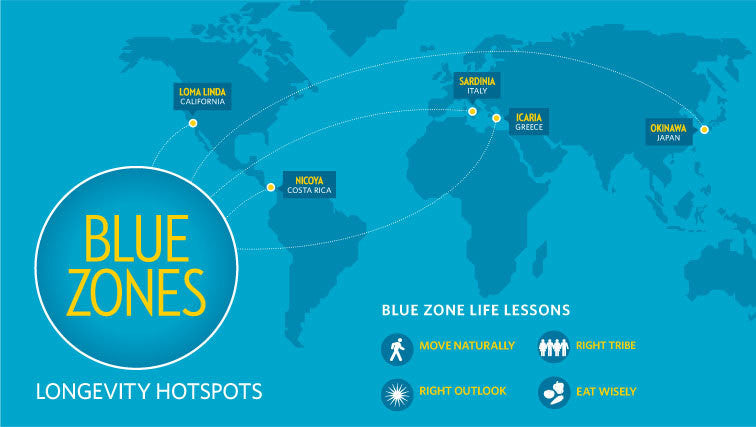Blue Zones
Are places where people live to an older age.
There’s a few key similarities between these zones;
Community and belief often religious.
A reason for living a purpose. Like the Japanese Ikigai.
They all move a lot with morning rituals and lots of gardening.
More or less all the regions grow their own vegetables and spend time gardening.
They all destress – making time to ‘make love on Sundays’ ;)
Eating wise it’s all about the vegetables. They all eat tons of vegetables, herbs, beans, spices and the like. It’s a phytochemical rich diet.
There’s an absence of processed foods.
There’s an absence of refined foods
They eat meats, fish and protein in moderation – some but not too much.
They eat grains, flat breads, some eat cheeses made from sheep and goat’s milk, not cow’s milk.
They often drink teas, green or herbal based teas to further support antioxidant levels in the body.
There’s slight differences in the types of food from each region of course. However there always tends to be a couple of high nutrient density foods such as purple potatoes, papaya etc. Which has the pigmentation protection humans seem to need so much.
Some of the societies drink but always in moderation, normally 1-2 glasses of wine each day – not more.
Here’s a key part too they all eat until only 80% full. So they don’t stuff their faces. Normally they eat in a social setting furthering conversation, interaction and slowing eating speed.
In Okinawa they’d average 1700-1800 daily calories compared with the 2300-2500 we average in the Western World. So they are more active and they eat less.
You can eat like this with the Amino Man 2:1:1 Magic Macros ™
|
DESIRED WEIGHT (BW) |
PROTEIN PALMS = BW x 2.2g/kg divided by 4 daily meals |
CARB PALMS = BW x 1/g/kg DIVIDED By 4 DAILY MEALS |
FAT THUMB = BW x 1/g/kg DIVIDED By 4 DAILY MEALS |
|
50KG |
25g per meal ; 1 palm; 100g / 28.5g (based on chicken breast fillet) |
12.5g per meal ; 3 palms; 300g / 14g (based on broccoli) |
12.5g per meal ; 1 thumb for liquids ; 1 tablespoon / 15g (based on olive oil) 2 thumbs for hard fats; 2 tablespoons / 10g (based on almonds) |
|
60KG |
30g per meal ; 1 palm ; 200g / 34.24g (based on ham, not canned) |
15g per meal ; 3 palms; 300g / 15g (based on cauliflower) |
15g per meal ; 1 thumb for liquids; 1 tablespoon / 15g (based on coconut oil) 1 palm ; 100g / 14g (based on avocado flesh) |
|
70KG |
35g per meal ; 1 palm ; 100g / 31.06g (based on lean beef steak) |
17.5g per meal; 4 palms; 400g / 15.52g (based on asparagus) |
17.5g per meal ; 2 thumbs for liquids; 2 tablespoons / 22g (based on butter) 1⁄4 palm ; 25g / 16.5g (based on Brazil nuts) |
|
80KG |
40g per meal ; 1 1⁄2 palms ; 150g / 39g (based on tuna, canned in water, drained solids) |
20g per meal ; 11⁄2 palms ; 150g / 21.75g (based on peas) |
20g per meal ; 3 thumbs for liquids; 3 tablespoons / 22g (based on pesto sauce) |
|
90KG |
45g per meal ; 2 1⁄4 palms; 225g / 45.70g (based on uncooked prawns) |
22.5g per meal; 6 palms ;600g / 21.6g (based on raw spinach) |
22.5g per meal 2/3 palm ; 67g / 22g (based on cheddar cheese) |
|
100KG |
50g per meal ; 3 palms ; 300g / 54g (based on raw Pacific cod) |
25g per meal ; 1 palm; 100g / 23g (based on long-grain brown rice, cooked) |
25g per meal ; 2 thumbs for liquids ; 2 tablespoons / 28g (based on walnut oil) 1⁄2 palm ; 50g / 32.5g (based on walnuts) |
|
110KG |
55g per meal ; 3 palms ; 300g / 54.87g (based on fresh crab) |
27.5g per meal ; 12 (lots) palms; 120g / 28g (based on mixed salad leaves) |
27.5g per meal ; 2 thumbs for liquids ; 2 tablespoons / 28g (based on sesame oil) 1⁄2 palm ; 50g / 24.5g (based on dried pumpkin seeds) |
They also tend to eat lighter in the evening with a larger lunchtime meal. I’m not sure I agree with this as long as you create a lower energy environment for a greater period of the 24 hours I think you’ll benefit from the AMPK support you’d get from this.
So if you eat less in the day eat a bigger meal at night, if you eat more in the day eat a smaller meal at night.






